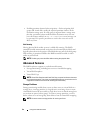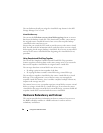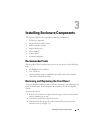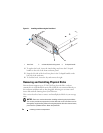
Using Your RAID Enclosure 49
NOTE: The best practice for ensuring data access is to avoid a configuration with a
single point of failure. A single point of failure is any component or path that is not
duplicated (redundant) or whose failure can cause loss of data access.
Redundancy and Non-Redundancy
Redundancy means that a storage array has duplicate components, or
alternate ways to provide essential services. This redundancy ensures access to
the virtual disks in case of a failure of a single component.
In a typical RAID configuration, most of the components are redundant;
however, the configuration itself might not be fully redundant. For example,
there might be components whose individual failure would cause loss of
access to the virtual disks. In a fully redundant storage array, all components
must be duplicated. In addition, the storage array must be configured in such
a way as to ensure that duplicate components can be accessed in case of a
failure.
The manner in which the storage array is cabled is essential for creating a
successfully configured redundant storage array. Refer to the
PowerVault
MD3000i Installation Guide
for examples of how to cable your host servers for
redundancy. After you have made a physical connection between your
MD3000i and host server, establish communication by using the iSCSI
software initiator on the host server to log in to the MD3000i target. For more
information on configuring your iSCSI connections, refer to the
PowerVault
MD Storage Manager CLI Guide.
Multi-Path Software
Multi-path software (also referred to as the failover driver) is software resident
on the host server that provides management of the redundant data path
between the host server and the RAID enclosure. For the multi-path software
to correctly manage a redundant path, the configuration must provide for
redundant iSCSI connections and cabling.
The multi-path software identifies the existence of multiple paths to a virtual
disk and establishes a preferred path to that disk. If any component in the
preferred path fails, the multi-path software automatically re-routes I/O
requests to the alternate path so that the storage array continues to operate
without interruption.
NOTE: Multi-path software is included with MD Storage Manager.


















